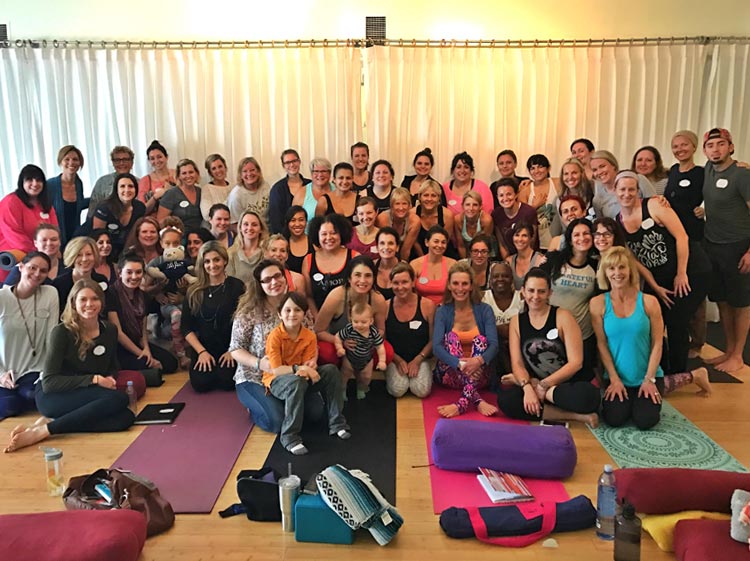 Have you ever looked at a prosperous yoga business and wondered what makes them successful? After an hour-long interview with Roni Elissabeth, owner of Bella Prana Yoga in Tampa, Florida, numerous reasons for their expansion over the past decade became evident. You can use the top 5 tips shared below to fuel your own growth in the yoga industry today!
Have you ever looked at a prosperous yoga business and wondered what makes them successful? After an hour-long interview with Roni Elissabeth, owner of Bella Prana Yoga in Tampa, Florida, numerous reasons for their expansion over the past decade became evident. You can use the top 5 tips shared below to fuel your own growth in the yoga industry today!
I found Bella Prana a few months back when dropping my mom off to the airport after a long, holiday visit. To combat hours in a car, I opted for a local yoga class. The Bella Prana site was inviting, and the class schedule was impressive. My expectations were blown out of the water by the kindness of the staff, the beauty of the space, and the quality of instruction.
Immediately I knew they were doing something–or many things–right in the yoga world. Since my mission is to share as many great business models in the industry with you, I reached out to Roni Elissabeth for an interview. Her journey is inspiring, and she provides practical tips on how you can enhance your own yoga business right now! So, let’s dive in!
Photo Credits: Bella Prana Yoga
HOW BELLA PRANA BEGAN
About eleven years ago, Roni found meditation as a way to alleviate the depression she was experiencing. As she started to understand the science behind the practice and felt the positive effects of meditation in her life, she wanted to share it.
Her go-get’em attitude led her to seek out a certification to teach meditation. And, since yoga and meditation go hand-in-hand, she completed a 200-hour yoga teacher training program. Without skipping a beat, she opened Bella Prana. But it wasn’t in the beautiful 6,000 square foot space you see today!
In fact, the first room she rented was in the back of a building with only a small sign on the door to acknowledge her presence.
“I wanted to open a space that was religiously neutral, but spiritually unapologetic.”
Despite the tough times in 2009, when people were tightening their purse strings and confused by the myth that yoga was a religion, she created a place for people to safely practice. Within 6 months, she outgrew that tiny room (which held only 5-10 students) and rented an easily-accessible location that could fit 25-30 people at a time.
The integrity and authenticity that founded Bella Prana kept growing still. And after two years, it bought out a nearby studio, the Lotus Room. Roni knew that it was very important for the Lotus Room teachers to keep their classes and their jobs. So, she built a space that had two rooms and could accommodate both the existing Lotus Room and Bella Prana schedules.
Fast-forward another three years, to 2016, and Bella Prana absorbed Yogani and found a home on Platt Street (in which they still reside). Today, they offer over 100 classes per week and have 40 instructors on staff. They provide 200- and 300-hour yoga teacher training programs and lead weekend workshops and trainings for their community.

(1) LEARN AS YOU GO
Each stage of a yoga business offers new learning opportunities. Roni notes that there are learning curves about the processes of your business and the systems you have in place. There is also learning about how you interact with money and loans. And perhaps the steepest learning curve comes in how you interact with people. This includes clients, colleagues, and staff.
How do you learn as you go?
Adopt an attitude of curiosity. In her book Dare to Lead, Brene Brown reveals that the brain’s chemistry changes when you become curious. Your creativity, intelligence, memory, and problem-solving skills all improve.
Yet remaining curious involves a lot of courage. It requires you to be calm and confident despite the tension of unknown outcomes. And, as Albert Einstein once said, “It’s not that I’m so smart, it’s just that I stayed with problems longer.”
Ways to stay in the learning mode:
- Refine the 3 essential skill sets to build and operate a yoga business. Discover which areas are weak and shore them up with books, podcasts, or working with a mentor.
- Talk to other professionals. If you manage other people, seek out wisdom from other leaders. If you’re a new independent contractor, talk to those you admire in similar positions who have found success already. People can be your greatest resource for learning–just make your selections thoughtfully.
- Gamify your interactions with money and your business. Make it as fun as possible.
(2) CULTIVATE A BUSINESS MINDSET FROM THE BEGINNING
Even though Bella Prana started in a small room tucked away from a street view, Roni had a vision of what the yoga business could become. She says:
“I think much of Bella Prana’s success stems from the fact that I always treated it like a business. I knew I had to produce certain things to have my life make sense. And, from the beginning, I knew that I was going to run the business–it wasn’t going to run me.”
From the beginning, there were specific requirements Bella Prana must meet–as a business–to keep the doors open. This included items like:
- Never going in the red. While the business might break even at times, the goal was to not go backward.
- Pay teachers per head. This ensured that the studio would not break the first rule by paying more in teacher salaries than income received from attendance. Another benefit of this model is that teachers are incentivized to grow their classes since they can make so much more money per class as their numbers increase.
- Establish clear boundaries. When everyone knows the rules and expectations–such as pay structure and staff meeting schedules–you create a stable environment for your teachers and students alike.
- Create a high value for customers. Underpromise. Overdeliver. Period.

(3) SHARE YOUR WHY WITH YOUR STAFF
At Bella Prana, desk angels have the role of greeting students and welcoming them into the space. Their position is extremely important since the studio is open 7 days a week from 6 am to 9 pm. Desk angels are also responsible for keeping the studio space tidy, such as folding and stacking blankets in the three yoga rooms.
This last responsibility can seem boring or tedious. Yet, each desk angel is given the reason behind the policy. They are reminded that they are not just folding blankets, they’re designing an environment for people.
“All folded blankets are to be stacked with the fringe-edge against the wall. Why? Because the fringe side looks chaotic and the closed, round edge looks soothing. Every single thing in our space is designed to create a certain feeling for our students. You might have mom’s coming from a home that has toys everywhere or someone working in a chaotic space. Yet when they walk into a clean room with clean lines, they can automatically take a deeper breath.”
When these reasons are conveyed in an honest manner, and people know that you mean what you say, then there is no convincing required. It invites people to take ownership in their part of making the entire team and business success. And they can get excited about that!
How can I apply this to my solo operation?
On the flipside, you might be thinking, “Well, I don’t run a staff or have team members of my own.” Yet, you likely work at a location that does. If you’re a teacher or staff member at a studio, ask yourself:
- Does your location have systems in place that are serving you? Why/why not?
- Do you know the “why” behind the systems in place?
- How could you get more clarity about them?
- Whom could you approach for more information about those systems?
(4) WELCOME NEW STUDENTS WITH COMPASSION
Whether you have a staff of desk angels, or you run your yoga business alone, how you interact with new students is of great importance. The first interaction someone has with you could make or break their yoga experience. As Roni says,”
“Often times people come to yoga because something went wrong–they had an injury or divorce or depression. So they’re naturally going to be a bit more on edge when they enter an unfamiliar yoga space. For example, anyone can go to a spin class and ride a bike–it’s not uncomfortable and most people won’t be worried about how other people view them when in that class. But yoga can stir up anxiety about looking silly or not fitting in. So people are much more concerned–in a subconscious way–about how they are going to look when coming to a yoga studio. Our front desk staff knows and understands the delicacy of the interactions they are having with new people.”
That being said, your first interaction with new clients might look simple. You could have the necessary paperwork, like client intake forms and liability waivers–signed when you meet. But, the delicacy of the interaction extends far beyond the logistics.
Likely students are coming to yoga because they seek something in their lives that will provide greater balance. How they perceive yoga can all be affected by how you say hello.
The best way to practice compassion? Start with yourself.
As a yoga professional, you might find it very easy to show compassion for others. But what happens when you look in the mirror? Do you extend the same generosity to yourself as you would with new students?
Dr. Kristin Neff, author of Self-Compassion: Stop Beating Yourself Up and Leave Insecurity Behind, says that there are three elements you can practice today to be more compassionate with yourself.
- Self-kindness. This starts with talking to yourself in a warm and understanding way (especially when you skrew up).
- Humanity. Connect with others who have had similar experiences, and learn from them. You’re not alone, and the sooner you reach out to a trusted friend who can show empathy and honesty, the sooner you’ll flow more compassion to yourself and others.
- Mindfulness. Pay attention to which thoughts and emotions are yours… and which ones you collect from your environment. Then take ownership of yours only, and let the rest go.

(5) HANDLE CONFLICT LIKE A BIG-HEARTED BOSS
This compassion as a yoga professional extends beyond when you meet new students. It overflows into your approach to customer service as a whole. When a client is unhappy or upset, or a conflict arises at the studio with a student, here are the steps that Bella Prana takes to resolve the issue:
Step 1: Notify the owner. This removes any responsibility–and the associated stress–of handling the situation away from that of a teacher or front desk angel.
Step 2: Review the situation. The owner reviews the issue and decides the course of action.
Step 3: Make a personalized call. Personal interaction goes a long way in today’s tech-based society. This is a huge step to show that you care.
Step 4: Apologize for the experience. Bella Prana always wants to exceed expectations of their customers, and they want to know when things go awry. This helps them stay curious about how to serve the community most effectively. When a client doesn’t get the best of Bella Prana, they apologize. This heartfelt gesture brings reconciliation to the upset.
Step 5: Offer something for free. REI has a 100% satisfaction guarantee policy with their gear, and you have a lifetime to take them up on that offer. After her time working there, Roni adopted this policy to build immense trust in her own community. Offering something for free to upset clients is a way to do just that. And, it gives Bella Prana a chance to make it right for the client when they come back next time.
What’s your policy?
It can be extremely helpful to have a plan in place–even if a skeleton version–before you encounter an angry yoga client. So, ask yourself these questions:
- Do I have a customer satisfaction guarantee?
- If no, what steps can I take to create one now?
- If yes, where is it located? Does my staff know about it and how to implement it?
PUTTING IT TOGETHER
Every decision you make in your yoga business adds to or detracts from your overall success. At Bella Prana Yoga, they have consciously set practices in place to serve their team and community more effectively. The 5 tips for success you can implement now include:
- Cultivating a business mindset from the beginning
- Learning as you go
- Knowing, and sharing, your “why” with your staff
- Welcoming new students with compassion, and
- Handling conflict with a big heart
Again, I’d like to extend a huge thank you to Roni Elissabeth for sharing the tips that she, her co-owner Tina Tidwell, and their staff use on a daily basis to shine such a bright light in the Tampa, Florida area. Should you ever find yourself in this part of the sunshine state, stop in and say hello! You’ll be glad you did!








Leave A Comment